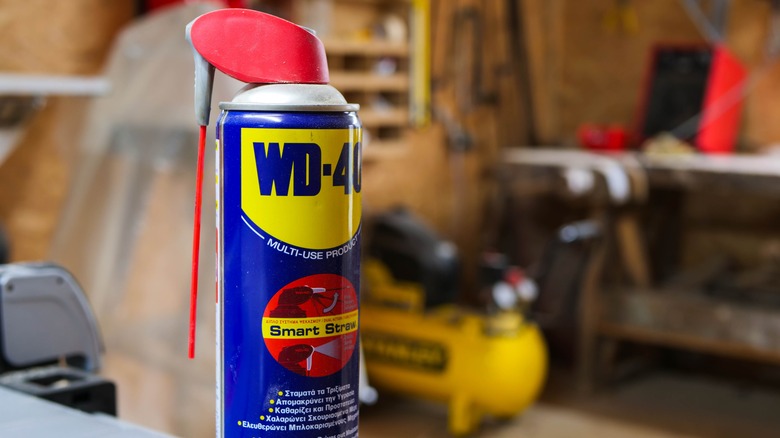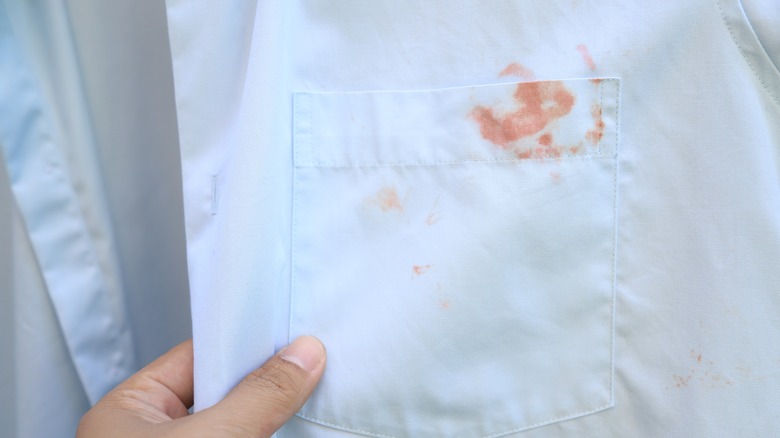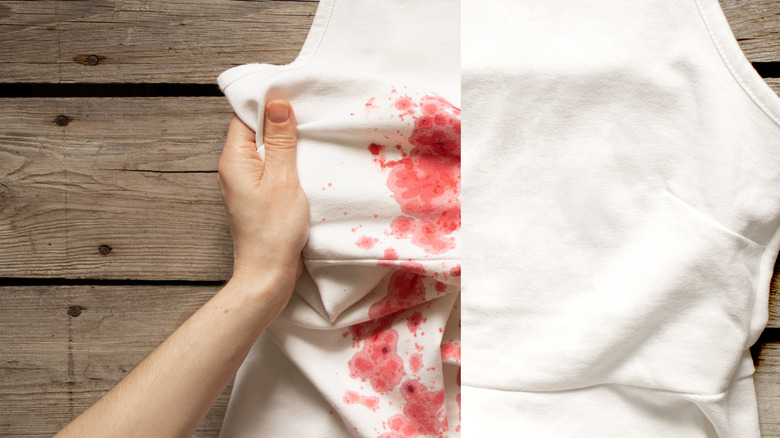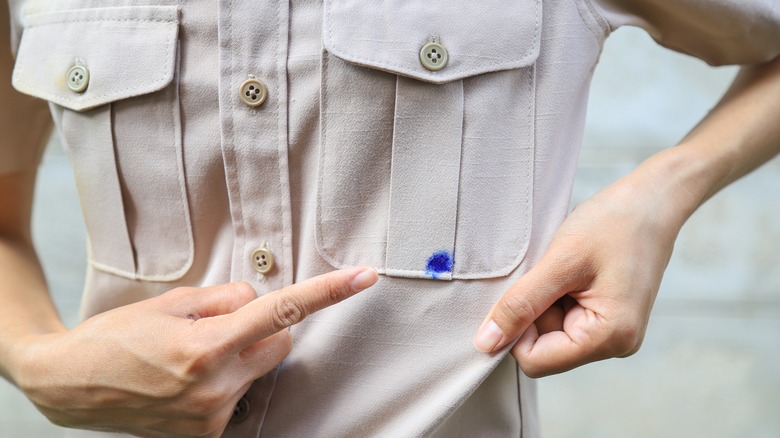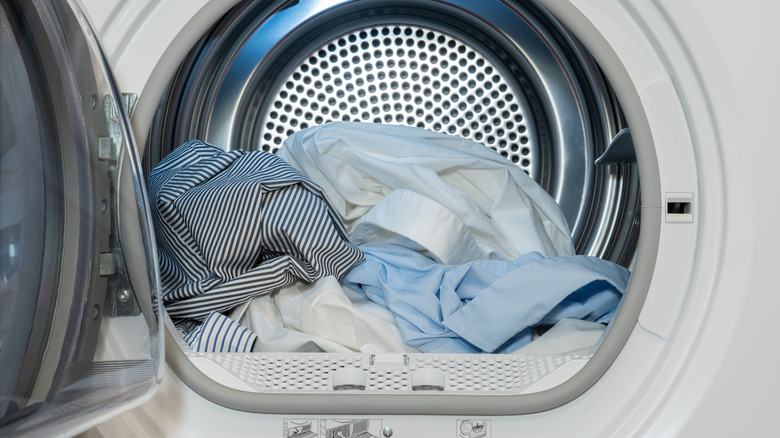Why You Should Keep A Bottle Of WD-40 In Your Laundry Room
If you're like most people, there are probably all sorts of items in your laundry room: Detergent, fabric softener, clothespins, vacuums and brooms often reside in there. You probably don't have a bottle of WD-40 hanging out in your clothes-washing space, though — but you should. WD-40 might be well known for its usefulness in other parts of your home, but it should be just as celebrated for its uses involving clothes and other laundry-related surfaces.
WD-40 truly is a multi-purpose spray that can remove the strongest adhesive off of surfaces, oil squeaky hinges, and wipe away leftover mess from your toddler's highchair. Its versatile cleaning power can also remove all sorts of stains from a variety of fabrics, and even clean your laundry-centric appliances. These uses make it a practical (albeit surprising) can to keep in the laundry room.
Removing stubborn rust from clothing
Rust stains are notoriously difficult to eradicate from clothing, which can be a big problem, because these stains are also very noticeable. While you may want to reach for your bleach spray, this will only make the stain unremovable in the future (as will applying heat to the stain).
WD-40 can lift rust stains out of your clothes, so long as you catch them before making the aforementioned mistakes. On a sunny day, spray a generous spritz of WD-40 to the rust stain and thoroughly blot it (a paper towel works well). Then take the apparel outside to sit in the sun. After about 10 minutes, you should be able to see the stain disappearing. If the rust stain is bad enough, you may need to repeat this process a few times until the discoloration is totally removed. To finish up, launder the article in a cold cycle. You should never see that particular stain again.
Eliminate blood stains
Another challenging substance to remove from cloth is blood. Blood can create a fast-setting stain that will utterly ruin an article of clothing. Because blood is filled with compounds that are designed to stick together when exposed to heat, throwing your stained shirt into a hot cycle will not help one bit. The good news is, WD-40 can lift these unsightly stains before they set into your laundry.
Simply spray the stain with WD-40 as soon as possible before running it through a wash cycle. The WD-40 should loosen the blood particles from your item and leave it spotless. A cold water wash after pre-treating with WD-40 will also prevent any residual stains from getting set at high temperatures. Before you transfer the item directly to the dryer, it is a good idea to examine the formerly stained area for any leftover blemishes. If you find that there's a little more blood remaining, going through another round of this stain removing protocol may be for the best.
Scrub out paint splatter
You've been there before: A small and unassuming painting job needs to be completed (something as simple as touching up where the dog scratched the front door, perhaps) and you're too busy — and maybe too confident in your abilities — to change into clothes you can afford to get messy. Before you know it, there's a noticeable paint stain on your shirt and you cannot forgive yourself for being so careless. Before you're too hard on yourself, however, know this: WD-40 can significantly help you in your plight to return your clothing to its former paint-free glory.
In addition to WD-40, you will need a couple microfiber cloths, a sponge, a bowl of water, and some dish soap. Spray the paint-stained portion with WD-40 and blot it with a sponge. Follow that with a microfiber cloth, wiping away whatever paint you can. After this, soak the item in soapy water and scrub the stain again with a clean cloth. This should yield a perfectly clean article of clothing (although you may need to repeat the process if there is residual paint).
Erase rust from appliances
Maybe it's the volume of Pinterest and TikTok content you've been consuming lately, but your laundry room suddenly feels utterly uninspiring and lackluster. While totally revamping your laundry room into the functional space of your dreams could be a great idea, there may be an easier and significantly cheaper way to breathe new life into it: Restoring your washer and dryer to their formerly gleaming glory by removing rust stains.
It's not at all uncommon for metal laundry machines to begin to succumb to rust stains — after all, metal and water create the perfect environment for rust to form. To remove rust from your appliances, spray the rusty portion with a hefty amount of WD-40 and leave it for 10 minutes. Use the abrasive side of a sponge to scrub the portions of rust that can be physically removed, then polish it with a microfiber cloth. For minor rust marks on your appliance, it may only be necessary to spray the WD-40 on for a few minutes, after which you can easily erase the stain with a microfiber cloth. Voila — now you have a nice, clean, washing machine and dryer.
Remove stains from your dryer
There is little more demoralizing than realizing a renegade crayon has made its way into your dryer and left stains throughout the drum. Not only do the stains look awful, they pose a threat to future laundry that will be run through the appliance. While the crayon may be cool to the touch now, running the dryer again will heat up the residue, making it sticky and prone to ruining your next load.
To get rid of the marks in a timely manner, scrape away as much of them as you can (a credit card or flexible bowl spatula works well). Then douse a cloth with WD-40 and wipe the marks until they fully come off. It's important to ensure that none of the chemical remains in your dryer, so use a wet cloth to wipe down the sections that were exposed to WD-40 before you use the appliance again.
Finally, remember that while it is a helpful resource, there are many places throughout the house that you should not use WD-40. WD-40 is highly flammable and could pose a risk if used improperly in an appliance that generates so much heat, like a dryer. Never use it to fix a squeaky drum, and avoid getting it into the inner workings of the dryer, which could result in a fire.

